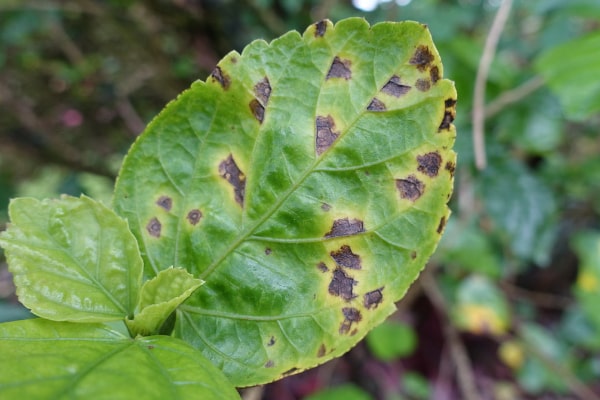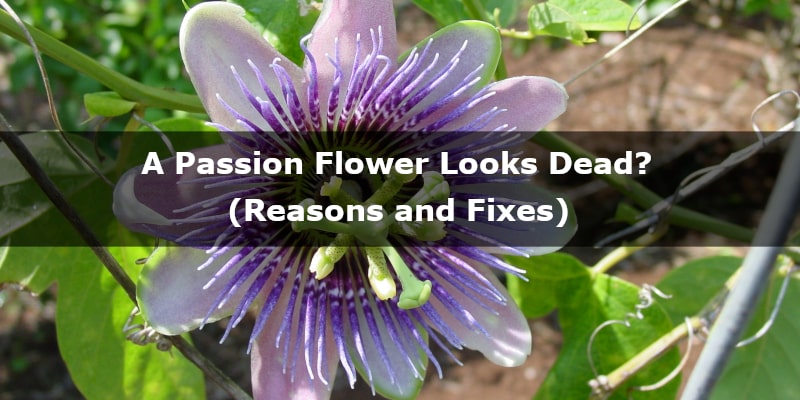So, your passion flower looks dead?
Don’t worry, in this post, I listed all the possible reasons behind poor-looking passion flowers, and I wrote what you can do to revive the flower.
Why Does Your Passion Flower Look Dead?
There are 12 popular reasons behind the dying passion flower. The most common ones are diseases like root-knot nematoda, fusarium wilt, or bacterial spot. In many cases, the plant can be revived.
Passion flower is a subtropical plant that is susceptible to many diseases. It’s especially common when it comes to purple-fruited varieties.
In many cases, the dying passion flower will be because of diseases that are pretty easy to recognize. However, there might also be other problems like lack of fertilization, improper watering, or preparing to fruiting.
Read this article, identify what’s wrong with your passion vine, and learn how to treat your plant correctly.
Root-Knot Nematode
Symptoms: The plant is turning yellow, with slow growth
One of the most common pests that are damaging passion flowers is root-knot nematode infestation. It’s a microscopic worm that invades the soil and the roots of the plants in the soil.
Usually, sweet-tasting, purple-fruited subspecies are highly susceptible to this pest. Yellow-fruited subspecies are resistant to nematodes.
The signs of root-knot nematode presence include stunted plant growth and yellow color to the plant. If the root system is deformed, or harry, and root knots or bumps appear on the root, it’s probably a root-knot nematode issue.
It’s not easy to get rid of this pest. The best method is soil solarization that’s an environmentally friendly method of using the sun’s power to control pests.
Fusarium Wilt
Symptoms: Plant wilting, foliage yellowing, stunted growth
Fusarium is a fungus that attacks younger passion flowers by entering the roots of the flower and blocking vessels in the cells, and as a result, the cells can’t transport water and nutrients to the plant.
The symptoms of this fungus include wilting of the plant, then the foliage fading, and yellowing, and the growth of the plant is stunted. The plant may seem to recover in the dark, but over time, the passion flower will die, or perform poorly, and produce few flowers.
To treat fusarium, you need to apply a fumigant that’s used as a root soak. Just remove the soil from around the roots, and rinse completely. Then soak the roots or storage organs in a bucket of fresh water with the appropriate amount of a fungicide.
Cucumber Mosaic Virus
Symptoms: Stunted growth, leaf distortion
The cucumber mosaic virus isn’t only limited to cucumbers. It attacks passion flowers as well. This disease is the transfer of the virus from one infected plant to another through the bite of an aphid.
Affected passion flowers show a mosaic-type mottling in the leaves, along with stunted growth and leaf distortion.
Unfortunately, there’s no cure for this virus yet, and it’s recommended to remove affected plants in your garden to prevent the further spread of the virus.
Bacterial Spot

Symptoms: Round, brown spots on the leaves growing larger
The passion vine is also susceptible to the bacteria Xanthomonas- the organisms that cannot be seen with the naked eye. Wet, cool conditions promote the formation of these bacteria, which can spread on plants quickly.
The disease begins with small, round, brown spots on the leaves. These spots can grow larger, kill the leaves, reduce photosynthesis, enter the vascular system, reduce plant vigor, damage fruit, and even decimate the whole plant.
It’s easier to prevent this disease than to treat it. Prevention is all about applying a fungicide, like this one on Amazon. You should also remove the affected leaves at the first sign to prevent the bacteria from jumping onto adjacent leaves.
Anthracnose
Symptoms: Small, brown dots on the underside of leaves
Anthracnose is a fungal disease that attacks plants in the spring when the weather is cool and wet. Weather like this creates perfect conditions for the spores to spread. Dry and hot weather stop the progression of the disease, that may begin again once the weather conditions become optimal.
You can easily recognize this disease by examining the undersides of leaves for a number of small tan to brown dots, about the size of a pin head.
Chemical treatment isn’t recommended. Instead, you should pick up and dispose all diseased plant parts, like twigs and leaves, from the ground or from around the plant, as they spread the fungi. Also, prune the plant properly to prevent the disease.
Phytophthora Root Rot
Symptoms: Dull, yellow, red, purple leaves that are falling off
This is another fungus, appearing in the spring and fall. It often attacks young plants.
The symptoms of phytophtora weaken the plant, and cause collapse. You should recognize this disease when the passion flower look as if it’s underwatered, even though it’s watered properly.
In order to save your passion vine, let the root system dry by removing the soil from around the base of the tree all the way down to the top of the main roots. Then cut away any oozy or dark bark and leaving the root system exposed.
Insects
Symptoms: Wilting, yellowing, and dropping leaves, and webs on the leaves
Insects like spider mites might also attack your passion vine. They’re common during hot weather.
They suck the sap from the leaves and the stems. Reduction of sap will cause leaves to wilt, turn yellow, and drop. You can spot them easily, because most spider mites produce a web to protect eggs.
You can easily get rid of spider mites by spraying down the plant with a nozzled hose, and it will knock them off. You can also apply a neem oil (buy here on Amazon).
Other insects include aphids that show similar symptoms on the plant. However, you can also get rid of the with neem oil, or with natural predators like live ladybugs.
Improper Watering
Symptoms: Wilting leaves and flowers
If you don’t see any suspicious signs of disease, your passion flower might not be getting enough water.
This plant, if not watered enough, will start wilting, including leaves, and flowers.
To revive a dying passion vine, just water it regularly. You should check the soil drought level. If it’s 2-3 inches (5-8 cm) down, you should water it until the topsoil is wet, but not waterlogged.
Not Enough Sunlight
Symptoms: Wilting flowers
If your passion vine was growing properly, and now the leaves started wilting, it might be because you deprived it of the sun.
This plant grows best in full sun or partial shade. Thus, if it’s not getting at least 6 hours of sunlight per day, it might show signs like leaf wilting, yellowing, and dropping.
However, if you’re sure that the passion flower is getting enough sunlight, look for other reasons for bad condition of the plant.
Fertilization Need
Symptoms: Leaf drop
If your passion vine is losing leaves, it means that the plant needs to be fertilized. Fertilization won’t prevent leaf drop, but will help to grow new, healthy foliage.
By moderate fertilizing, you promote blooms, and healthy root system. You should apply a 10-5-10 fertilizer in early spring, just before new growth appears and followed by consecutive feedings every two months during the growing season
Preparing to Fruit
Symptoms: Glowers fade and drop off
In some areas, for example in Florida, because of hot weather, passion vine might have faded leaves that are dropping, because the plant is preparing to fruit.
That usually happens in the spring or early summer. The plant just finished blooming and prepares for another phase.
This is quite normal for this plant. The flowers should go back to normal within 2-3 months.
Frost
Symptoms: Brown, and scorched leaves
Passion flower isn’t a hardy plant. It’s a tropical plant that does best when the temperature is between 55-65 °F (12-18 °C). It can withstand lower temperatures, but usually not below 28 °F (-2 °C).
If your area was touched by severe frost, you might be sure that the passion vine is dead. It will have wilting, brown, and scorched leaves.

